The Read Mughal Album
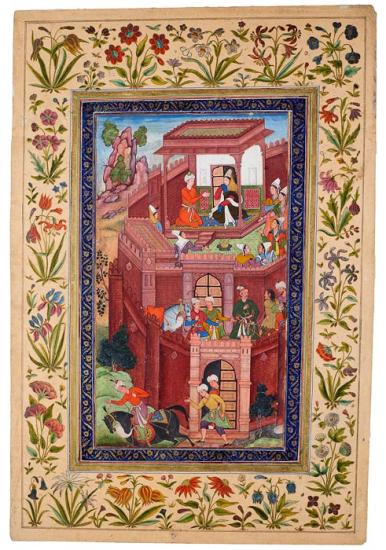
Bābur Seeks His Grandmother's Advice
Leaf from the Read Mughal Album, but formerly fol. 86 in the British Library's Bāburnāma, probably by Sānvalah
Purchasedby Pierpont Morgan, 1911
Bābur was the founder of the Mughal dynasty in India (r. 1526–1530). Although no artworks can be connected with his patronage, he completed the Bāburnāma (Memoirs of Bābur) shortly before his death. His grandson Akbar ordered a Persian translation, completed in 1589. In the 1590s, six illustrated copies were made, including the one in the British Library, London, from which this leaf comes.
According to Bābur, his grandmother, Esän Dawlat Begim, was very intelligent. In October 1494 he sought her counsel regarding the rebellious Ḥasan Ya˓qūb. They decided to depose Ya˓qūb, who, while hunting, learned of the plan and fled to Samarqand. The meeting took place in a rooftop red-stone pavilion. The miniature is probably by the artist Sānvalah (fl. 1580s–1590s).
The Read Mughal Album
Pierpont Morgan purchased the Read Mughal album, along with a Persian album, from Sir Charles Hercules Read, Keeper of British and Medieval Antiquities at the British Museum, in 1911. The Morgan purchase consisted of thirty folios (including both Indian miniatures and the Mughal portraits presented here), but Read owned at least forty-eight others, now widely dispersed. The leaves were probably once bound in several lacquered bindings. The identity of their compiler has not been established, but many borders date from the eighteenth and nineteenth centuries. The Mughal emperors of India commissioned biographies and were frequently portrayed by artists. Here the paintings are presented in the order of the emperor's reigns rather than the dates of the miniatures, starting with Bābur (r. 1526–30), the Muslim founder of the dynasty, and ending with Shāh Jahān (r. 1628–58), builder of the Taj Mahal.
Bābur and Two Companions Racing
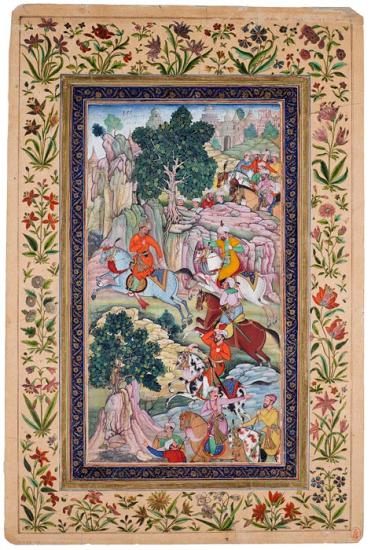
Bābur and Two Companions Racing During Their 1501-2 Flight from Samarqand
Leaf from the Read Mughal Album, but formerly fol. 121 of the British Library's Bāburnāma, probably by Sānvalah
Purchased by Pierpont Morgan, 1911
This is the second of two miniatures in the Read Mughal Album that were formerly part of the British Library's Bāburnāma (Memoirs of Bābur). According to Bābur, when he looked back to see how far Qambar-˓Alī and Qasim Beg were behind him, his girth strap snapped, causing him to fall on his head. "Although I stood up immediately and got back on," he wrote, "my brain did not return to normal until that evening." This miniature is probably by the artist Parasa, to whom four others in the British Library's manuscript have been attributed.
The Read Mughal Album
Pierpont Morgan purchased the Read Mughal album, along with a Persian album, from Sir Charles Hercules Read, Keeper of British and Medieval Antiquities at the British Museum, in 1911. The Morgan purchase consisted of thirty folios (including both Indian miniatures and the Mughal portraits presented here), but Read owned at least forty-eight others, now widely dispersed. The leaves were probably once bound in several lacquered bindings. The identity of their compiler has not been established, but many borders date from the eighteenth and nineteenth centuries. The Mughal emperors of India commissioned biographies and were frequently portrayed by artists. Here the paintings are presented in the order of the emperor's reigns rather than the dates of the miniatures, starting with Bābur (r. 1526–30), the Muslim founder of the dynasty, and ending with Shāh Jahān (r. 1628–58), builder of the Taj Mahal.
The Young Akbar
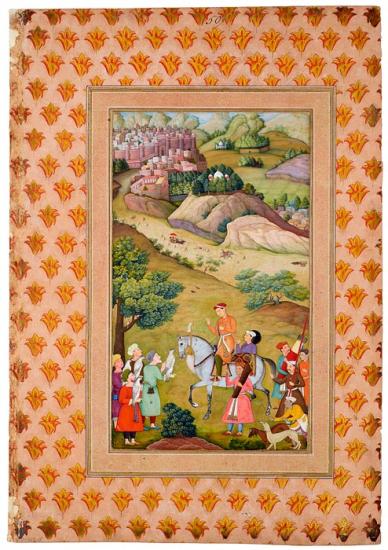
The Young Akbar with a Hunting Party
Leaf from the Read Mughal Album, probably by Manohar
Purchased by Pierpont Morgan, 1911
In 1589 the Mughal Emperor Akbar (r. 1556–1605) commissioned Abū al-Fażl to begin an account of his life. The result—the three-volume Akbarnāma, completed some seven years later—exists in at least three copies. This leaf was once part of the manuscript in the Chester Beatty Library, Dublin, which has paintings covering the period from the 1556 accession of the thirteen-year-old Akbar to the throne to 1579. According to Abū al-Fażl, Akbar's beard appeared when he was twenty-one, so the episode shown here probably occurred when, at age seventeen or eighteen, he left the army and headed to Lahore, hunting along the way. Akbar greets four men with falcons and is attended by men bearing a fan, sword, spear, quiver of arrows, and what appears to be a bow. A dog handler with two salukis occupies the lower right corner.
The Read Mughal Album
Pierpont Morgan purchased the Read Mughal album, along with a Persian album, from Sir Charles Hercules Read, Keeper of British and Medieval Antiquities at the British Museum, in 1911. The Morgan purchase consisted of thirty folios (including both Indian miniatures and the Mughal portraits presented here), but Read owned at least forty-eight others, now widely dispersed. The leaves were probably once bound in several lacquered bindings. The identity of their compiler has not been established, but many borders date from the eighteenth and nineteenth centuries. The Mughal emperors of India commissioned biographies and were frequently portrayed by artists. Here the paintings are presented in the order of the emperor's reigns rather than the dates of the miniatures, starting with Bābur (r. 1526–30), the Muslim founder of the dynasty, and ending with Shāh Jahān (r. 1628–58), builder of the Taj Mahal.
Prince Salīm at an Audience Window
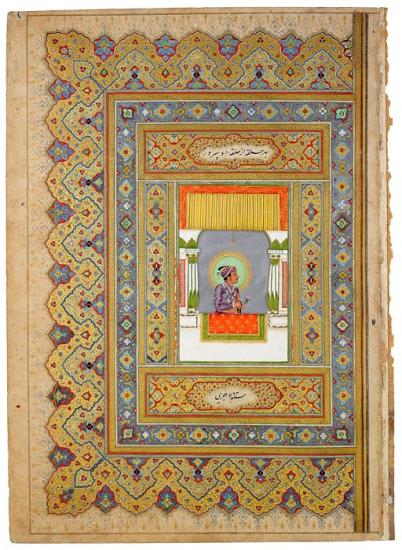
Prince Salīm at an Audience Window
Leaf from the Read Mughal Album
Purchased by Pierpont Morgan, 1911
This portrait of the Mughal emperor Salīm, who took the name Jahāngir (World-Seizer) when he ascended the throne (r. 1605–27), originally faced that of his father, Emperor Akbar (r. 1556–1605), shown on the right, when it was mounted in the album (see MS M.458.24). The rhyming couplet in the cartouche above Salīm, which ends with a date (1749–50), continues the one below Akbar. Both men have haloes, are shown at audience windows (jharokas), and were painted by the same artist. The portraits are applied to a type of elaborate border used for the opening pages of a manuscript (sarlauḥ). Indeed, as the leaf is numbered 1, these facing pages originally formed the opening of the Read Mughal album.
The Read Mughal Album
Pierpont Morgan purchased the Read Mughal album, along with a Persian album, from Sir Charles Hercules Read, Keeper of British and Medieval Antiquities at the British Museum, in 1911. The Morgan purchase consisted of thirty folios (including both Indian miniatures and the Mughal portraits presented here), but Read owned at least forty-eight others, now widely dispersed. The leaves were probably once bound in several lacquered bindings. The identity of their compiler has not been established, but many borders date from the eighteenth and nineteenth centuries. The Mughal emperors of India commissioned biographies and were frequently portrayed by artists. Here the paintings are presented in the order of the emperor's reigns rather than the dates of the miniatures, starting with Bābur (r. 1526–30), the Muslim founder of the dynasty, and ending with Shāh Jahān (r. 1628–58), builder of the Taj Mahal.
Akbar at an Audience Window
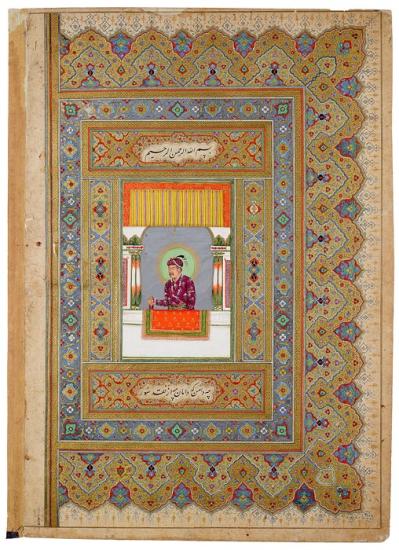
Akbar at an Audience Window
Leaf from the Read Mughal Album
Purchased by Pierpont Morgan, 1911
Akbar (r. 1556–1605) was one of the wisest and most important of the Mughal rulers. Although he preferred hunting to reading (he was illiterate) he sought out the learned. He employed over a hundred painters, and said he disliked men who hated painting. When it was mounted in the Read Mughal album, this portrait originally faced that of his son Salīm (see MS M.458.12), who was impatient to succeed him, even though his two brothers died early of alcoholism.
Below Akbar: In the name of God, the Merciful, the Compassionate / What skirt? It is a lap full of cash.
Above Salīm: In every ring, [of servitude] to him is happiness. / The year A.H. 1163 [A.D. 1749–50]
The Read Mughal Album
Pierpont Morgan purchased the Read Mughal album, along with a Persian album, from Sir Charles Hercules Read, Keeper of British and Medieval Antiquities at the British Museum, in 1911. The Morgan purchase consisted of thirty folios (including both Indian miniatures and the Mughal portraits presented here), but Read owned at least forty-eight others, now widely dispersed. The leaves were probably once bound in several lacquered bindings. The identity of their compiler has not been established, but many borders date from the eighteenth and nineteenth centuries. The Mughal emperors of India commissioned biographies and were frequently portrayed by artists. Here the paintings are presented in the order of the emperor's reigns rather than the dates of the miniatures, starting with Bābur (r. 1526–30), the Muslim founder of the dynasty, and ending with Shāh Jahān (r. 1628–58), builder of the Taj Mahal.
Hakīm Mu˒mina
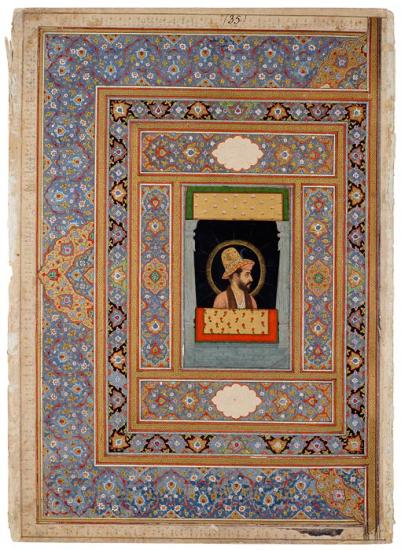
Bust Portrait of Hakīm Mu˒mina
Leaf from the Read Mughal Album
Purchased by Pierpont Morgan, 1911
Although such small portraits ended up in albums, they probably served as artist's models for larger works. Although the portrait head is a Mughal work of about 1620, it became part of the Read Mughal album in the second half of the eighteenth century, when the portrait was extended to become a bust, and the black background, halo, and elaborate borders were added. Mu˒mina, who served as the Mughal emperor Jahāngīr's physician, is shown at a jharoka (audience window). His European-style hat—popular in India—is embroidered with a lion battling a dragon. The page is numbered 35.
The Read Mughal Album
Pierpont Morgan purchased the Read Mughal album, along with a Persian album, from Sir Charles Hercules Read, Keeper of British and Medieval Antiquities at the British Museum, in 1911. The Morgan purchase consisted of thirty folios (including both Indian miniatures and the Mughal portraits presented here), but Read owned at least forty-eight others, now widely dispersed. The leaves were probably once bound in several lacquered bindings. The identity of their compiler has not been established, but many borders date from the eighteenth and nineteenth centuries. The Mughal emperors of India commissioned biographies and were frequently portrayed by artists. Here the paintings are presented in the order of the emperor's reigns rather than the dates of the miniatures, starting with Bābur (r. 1526–30), the Muslim founder of the dynasty, and ending with Shāh Jahān (r. 1628–58), builder of the Taj Mahal.
Young Dārā Shikoh
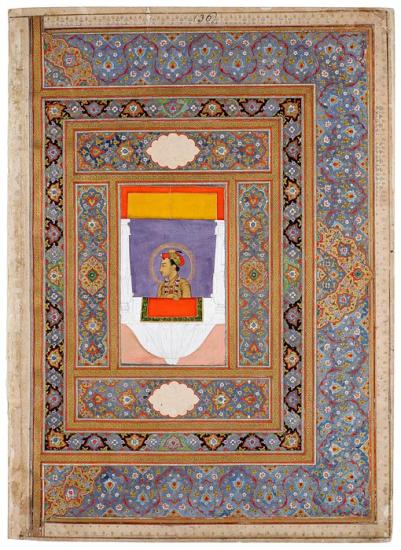
Bust Portrait of the Young Dārā Shikoh
Leaf from the Read Mughal Album, probably by Hāshim
Purchased by Pierpont Morgan, 1911
Dārā Shikoh, the eldest son of the Mughal emperor Shāh Jahān, was born in 1615. Since here he appears to be in his late teens, this portrait was probably painted in the early 1630s. The extremely fine facial depiction has been attributed to the painter Hāshim, but the background, marble window frame, halo, and elaborate border were added during the second half of the eighteenth century, when the album was assembled. The page, numbered 36, originally faced the portrait of Hakīm Mu˒mina (see MS M.458.5) in the Read Mughal album. The numeration, however, is in Western style, going from front to back.
The Read Mughal Album
Pierpont Morgan purchased the Read Mughal album, along with a Persian album, from Sir Charles Hercules Read, Keeper of British and Medieval Antiquities at the British Museum, in 1911. The Morgan purchase consisted of thirty folios (including both Indian miniatures and the Mughal portraits presented here), but Read owned at least forty-eight others, now widely dispersed. The leaves were probably once bound in several lacquered bindings. The identity of their compiler has not been established, but many borders date from the eighteenth and nineteenth centuries. The Mughal emperors of India commissioned biographies and were frequently portrayed by artists. Here the paintings are presented in the order of the emperor's reigns rather than the dates of the miniatures, starting with Bābur (r. 1526–30), the Muslim founder of the dynasty, and ending with Shāh Jahān (r. 1628–58), builder of the Taj Mahal.
Prince Dārā Shikoh
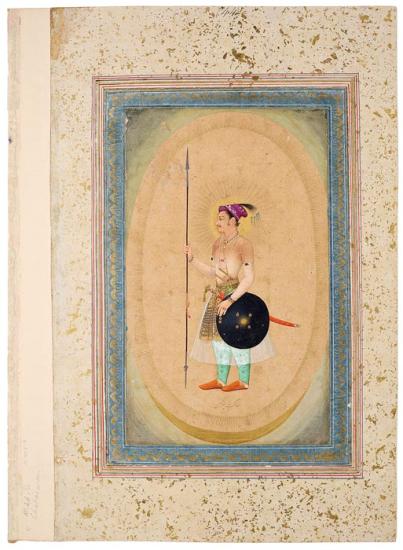
Prince Dārā Shikoh
Leaf from the Read Mughal Album, by Chitarman
Purchased by Pierpont Morgan, 1911
Dārā Shikoh (1615–1659) shared with his father, the Mughal emperor Shāh Jahān, an interest in calligraphy and art, becoming a great patron himself. His brother Aurangzeb had him killed in 1659, appropriated his art collection, and usurped Jahān's throne. Since the portrait is dated 1639–40, Dārā Shikoh was about twenty-four years old. He is shown fully armed, with the cosmic symbols of Mughal kingship; the sun (mandorla and halo) and moon beneath his feet. The artist's signature, He, who is dust under his feet, Chitarman, is written in gold beneath the shoes of his patron. Chitarman (active 1628–ca.1670) signed at least three other portraits of Dārā Shikoh, whose atelier he entered early in his career.
The Read Mughal Album
Pierpont Morgan purchased the Read Mughal album, along with a Persian album, from Sir Charles Hercules Read, Keeper of British and Medieval Antiquities at the British Museum, in 1911. The Morgan purchase consisted of thirty folios (including both Indian miniatures and the Mughal portraits presented here), but Read owned at least forty-eight others, now widely dispersed. The leaves were probably once bound in several lacquered bindings. The identity of their compiler has not been established, but many borders date from the eighteenth and nineteenth centuries. The Mughal emperors of India commissioned biographies and were frequently portrayed by artists. Here the paintings are presented in the order of the emperor's reigns rather than the dates of the miniatures, starting with Bābur (r. 1526–30), the Muslim founder of the dynasty, and ending with Shāh Jahān (r. 1628–58), builder of the Taj Mahal.
Khiżr Presents a Globe to Shāh Jahān
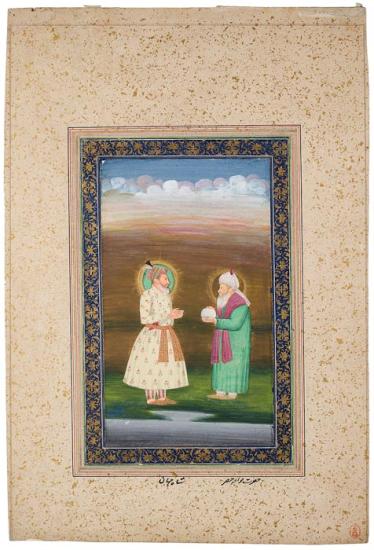
Khiżr Presents a Globe to Shāh Jahān
Leaf from the Read Mughal Album
Purchased by Pierpont Morgan, 1911
On a 6 November 1654 trip to Ajmer, the Mughal emperor Shāh Jahān had a vision of the prophet Khiżr as he approached the city walls. Khiżr, who set off with Iskandar (Alexander the Great) to search for the water of eternal life, was regarded as the spiritual founder of the Chishtī order of Sufis centered at Ajmer. A seventeenth-century miniature in St. Petersburg shows Khiżr presenting a globe upon which a glass of water rests. The globe suggests peaceful dominion, and the water may refer to eternal life. In this miniature, however, a body of water in the foreground replaces the glass. Khiżr wears his customary green (his name means "the green one"). Both men have haloes and are identified by inscriptions.
The Read Mughal Album
Pierpont Morgan purchased the Read Mughal album, along with a Persian album, from Sir Charles Hercules Read, Keeper of British and Medieval Antiquities at the British Museum, in 1911. The Morgan purchase consisted of thirty folios (including both Indian miniatures and the Mughal portraits presented here), but Read owned at least forty-eight others, now widely dispersed. The leaves were probably once bound in several lacquered bindings. The identity of their compiler has not been established, but many borders date from the eighteenth and nineteenth centuries. The Mughal emperors of India commissioned biographies and were frequently portrayed by artists. Here the paintings are presented in the order of the emperor's reigns rather than the dates of the miniatures, starting with Bābur (r. 1526–30), the Muslim founder of the dynasty, and ending with Shāh Jahān (r. 1628–58), builder of the Taj Mahal.
Bahādur Shāh
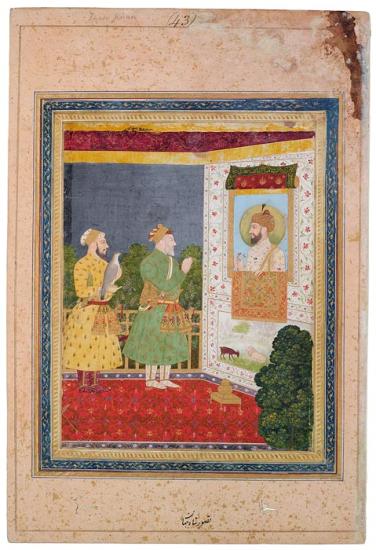
Bahādur Shāh Pays Homage to His Ancestors
Leaf from the Read Mughal Album
Purchased by Pierpont Morgan, 1911
The Mughal rulers adopted the Hindu custom of appearing to their subjects in a special audience window called the jharoka. In this rare version of the theme, however, it is not the reigning monarch who appears in the window but his ancestor. In a similar miniature in the Victoria and Albert Museum, London, the man before the window is identified as Bahādur Shāh (r. 1707–12), son and successor of Aurangzeb (r. 1658–1707), likely the figure depicted in the window. The dynastic link goes even further back, as the latter's turban is of central Asian origin and thus associated with his primogenitor, Bābur, founder of the dynasty. The goat and reclining lion depicted below the window suggest a reign of peace and justice as well as the enduring majesty of Mughal rule from Bābur to Bahādur Shāh.
The Read Mughal Album
Pierpont Morgan purchased the Read Mughal album, along with a Persian album, from Sir Charles Hercules Read, Keeper of British and Medieval Antiquities at the British Museum, in 1911. The Morgan purchase consisted of thirty folios (including both Indian miniatures and the Mughal portraits presented here), but Read owned at least forty-eight others, now widely dispersed. The leaves were probably once bound in several lacquered bindings. The identity of their compiler has not been established, but many borders date from the eighteenth and nineteenth centuries. The Mughal emperors of India commissioned biographies and were frequently portrayed by artists. Here the paintings are presented in the order of the emperor's reigns rather than the dates of the miniatures, starting with Bābur (r. 1526–30), the Muslim founder of the dynasty, and ending with Shāh Jahān (r. 1628–58), builder of the Taj Mahal.
Ibrāhīm Ibn Adham of Balkh
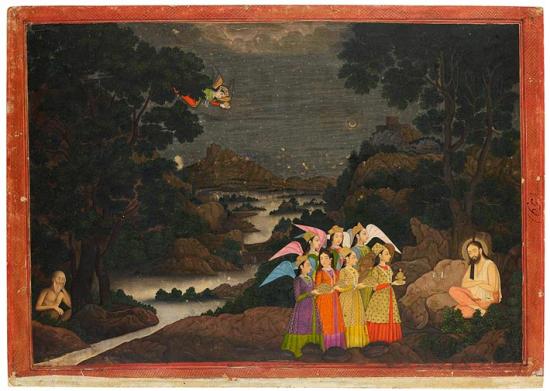
Ibrāhīm Ibn Adham of Balkh Served by Angels
From the Read Mughal Album, attributed to Mīr Kalān Khān
Purchased by Pierpont Morgan, 1911
After a spiritual awakening, Ibrāhīm Ibn Adham (d. 798), an eighth-century ruler of Balkh, renounced his kingdom and wealth to become a wandering dervish. Part of his spiritual awakening happened one night when he heard people on the roof of his palace. When he made inquiry, a man told him they were looking for a lost camel. Ibrāhīm then replied it was ridiculous to expect that the camel would be on the roof of his palace. The man then said it was equally crazy to expect to find Allah in the lap of luxury. Ibrāhīm then realized that his hope of finding Allah in his present surroundings was as futile as searching for a camel on his roof.
Rūmī (1207–1273), a later Sufi mystic, also born in Balkh, recounted Ibrāhīm's story in his six-volume poetic work, the Masnavī. Legend has it that Khiżr, the immortal guide of the Sufi, played a role and that Ibrāhīm, regarded as a spiritual ancestor of the Chrishtī Sufi order, was fed by angels. Here the haloed Sufi shaikh (spiritual master) sits at the right, with eyes closed and supported by a staff. Seven angels have already arrived, and an eighth is en route. A pensive man, at the far left, echoes the figure of Ibrāhīm.
The subject may have been inspired by engravings of Christ fed by angels in the wilderness. The painting is probably by Mīr Kalān Khān, who was active in Oudh and Delhi during the 1760s.
The Read Mughal Album
Pierpont Morgan purchased the Read Mughal album, along with a Persian album, from Sir Charles Hercules Read, Keeper of British and Medieval Antiquities at the British Museum, in 1911. The Morgan purchase consisted of thirty folios (including both Indian miniatures and the Mughal portraits presented here), but Read owned at least forty-eight others, now widely dispersed. The leaves were probably once bound in several lacquered bindings. The identity of their compiler has not been established, but many borders date from the eighteenth and nineteenth centuries. The Mughal emperors of India commissioned biographies and were frequently portrayed by artists. Here the paintings are presented in the order of the emperor's reigns rather than the dates of the miniatures, starting with Bābur (r. 1526–30), the Muslim founder of the dynasty, and ending with Shāh Jahān (r. 1628–58), builder of the Taj Mahal.
Peri Riding a Composite Horse
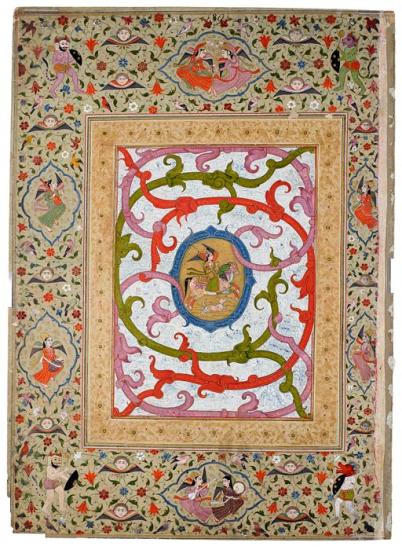
Peri Riding a Composite Horse
From the Read Mughal Album
Purchased by Pierpont Morgan, 1911
Composite drawing, or symplegma (intertwined), is documented in Islamic painting in Persia and Mughal India as early as the sixteenth century. Here, within an oval surrounded by acanthus scrolls, a peri (a supernatural being thought to have descended from a fallen angel) rides a horse made up of many smaller intertwined animals. The horse's tail, for instance, is actually a woman's flowing black hair. Between the vines are tiny blue drawings of animals—many in pairs—cherubs, men fighting monsters or served by angels, and Rustam killing a div (demon). This and the facing page (MS M.458.15 in the Read Mughal album) were made possibly in Kashmir during the second half of the eighteenth century.
The Read Mughal Album
Pierpont Morgan purchased the Read Mughal album, along with a Persian album, from Sir Charles Hercules Read, Keeper of British and Medieval Antiquities at the British Museum, in 1911. The Morgan purchase consisted of thirty folios (including both Indian miniatures and the Mughal portraits presented here), but Read owned at least forty-eight others, now widely dispersed. The leaves were probably once bound in several lacquered bindings. The identity of their compiler has not been established, but many borders date from the eighteenth and nineteenth centuries. The Mughal emperors of India commissioned biographies and were frequently portrayed by artists. Here the paintings are presented in the order of the emperor's reigns rather than the dates of the miniatures, starting with Bābur (r. 1526–30), the Muslim founder of the dynasty, and ending with Shāh Jahān (r. 1628–58), builder of the Taj Mahal.
Three Peris Riding a Composite Elephant
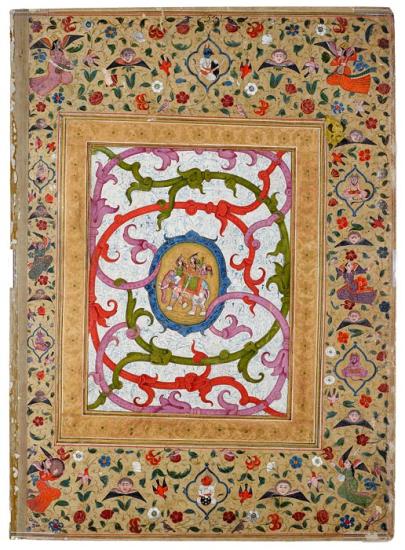
Three Peris Riding a Composite Elephant
From the Read Mughal Album
Purchased by Pierpont Morgan, 1911
Originally this page must have faced the miniature Peri riding the composite horse (see MS M.458.14 in the Read Mughal album), though they were later numbered 52 and 39. The composition of the elephant—especially the rabbit feet—is remarkable. Here, too, some of the tiny blue drawings can be identified, such as Lailā and Majnūn with animals, a hero borne by divs (demons), and Ibrāhīm Ibn Adham of Balkh (an eighth-century ruler) served by angels, the subject of another page in the album (see MS M.458.32). The matching borders contain an assortment of angels, some making music, along with birds, flowers, and armed horned demons.
The Read Mughal Album
Pierpont Morgan purchased the Read Mughal album, along with a Persian album, from Sir Charles Hercules Read, Keeper of British and Medieval Antiquities at the British Museum, in 1911. The Morgan purchase consisted of thirty folios (including both Indian miniatures and the Mughal portraits presented here), but Read owned at least forty-eight others, now widely dispersed. The leaves were probably once bound in several lacquered bindings. The identity of their compiler has not been established, but many borders date from the eighteenth and nineteenth centuries. The Mughal emperors of India commissioned biographies and were frequently portrayed by artists. Here the paintings are presented in the order of the emperor's reigns rather than the dates of the miniatures, starting with Bābur (r. 1526–30), the Muslim founder of the dynasty, and ending with Shāh Jahān (r. 1628–58), builder of the Taj Mahal.
A Sun-bearing Peri Rides a Composite Lion
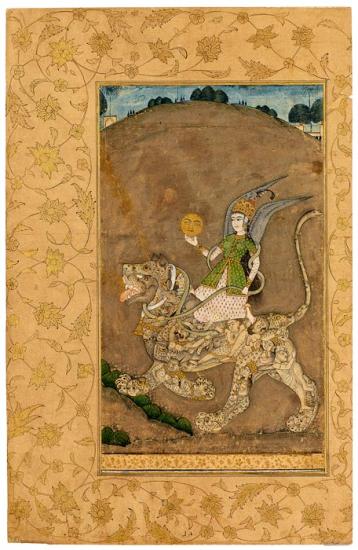
A Sun-bearing Peri Rides a Composite Lion
Purchased in 1935
Astrology was an important part of Islamic culture; this miniature actually represents Sol in Leo, the conjunction of the sun with the constellation Leo. What is unusual, however, is that the lion is a composite drawing, or symplegma, made up of many intertwined animals, human beings, and monsters. Sol in Leo also appears in MS M.788, an astrological treatise purchased with the leaf, but in that image the lion is not composite.
Sol in Leo.